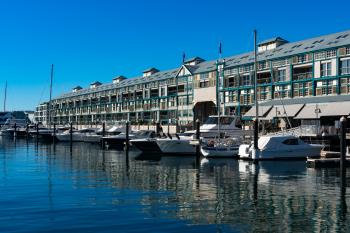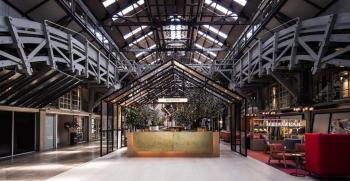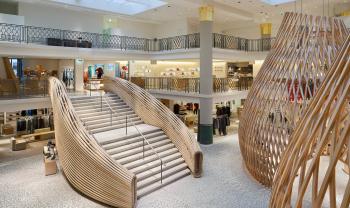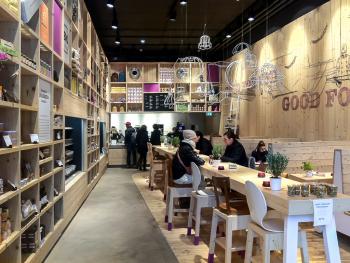THE CROSSOVER MOVEMENT
Natural materials and user-centric design
For this WoodSolutions exclusive, Tony Neilson interviewed Shinichi Mitsuki through an interpreter at the 2017 Malaysian International Furniture Fair in Kuala Lumpur.
‘Crossover’ is a facet of design with many applications and definitions, and a leading Japanese style-watcher thinks Australia is an outstanding example of the genre.
Shinichi Mitsuki, general manager of Mitsui Designtec, sees Australia as a very advanced country in several aspects of crossover. “It is a country of diverse cultures and ethnic groups with a mix of very modern, hi-tech cities, and at the same time very primitive and vast nature – all co-existing in the one country.”

Shinichi Mitsuki – Australia is ‘naturally advanced’ in crossover design
Unconventional design
Interviewed during the recent Malaysian International Furniture Fair (MIFF), Mitsuki spoke enthusiastically about the many unconventional design, environmental and social contrasts that ensured a high profile for Australia among global examples in his company’s new high-end book, appropriately titled Crossover Design.
Aimed at developers, the book features examples of “unconventional” Aussie crossover architectural designs using natural materials.

Mitsuki features Sydney’s iconic Woolloomooloo dining and lifestyle precinct in his crossover design book. Photo ©Stutterstock

Ovolo Woolloomooloo hotel – contemporary crossover and natural materials
The blood problem
Mitsuki says crossover is about designing the experience before designing the product or space. “Crossover connects people, space and time.”
He recently used the technique to encourage more young people in Japan to become blood donors. “The number of people donating blood in Japan has been falling quite alarmingly, particularly [among] the young generation. The [Red Cross] blood bank was very concerned and asked us to come up with new ideas to encourage young ones to donate.
“We studied the blood centres and found a very hospital-like, even toilet-like atmosphere in many of them, which was very discouraging.
“The first requirement was a space that would make young people feel good about going there. So we redesigned several of the blood banks in the style of a Starbucks coffee shop.”
Coffee shops
Each of the new centres features a different coffee shop style, but they are all representative of crossover design thinking: using juxtaposition and user-centric innovation.
Have they worked? “They are all doing very well and donations have increased,” says Mitsuki. “The atmosphere is much more familiar to young people who like to gather for coffee anyway, and they are encouraging other friends to go together to give blood. It is so good that the Japan Red Cross has adopted the concept on a broad front.”
An award winning ‘space designer’ with more than 20 years experience, Mitsuki says the crossover concept is also a leading the ‘hybrid chic’ trend in furniture design. “We are seeing a lot of combinations featuring natural materials such as wood and stone, and wood with glass inserts. Such combinations are creating unprecedented value.”
Natural materials
Ironically, he says, the emergence of things made with 3D printers has generated greater demand for products made from natural materials.
“Natural materials like wood age, and the character of the material changes. So the person who uses the thing made of wood can also age with that wood.
“People have a personal attachment to items crafted from wood and other natural materials. Things a craftsman may have spent years producing are of far greater value in this age of ‘instant solutions’. There is a hunger for ‘human touch’ products. That’s why we value natural items more than the 3D printed products.”
Mitsuki says the stressful modern working environment, plus increased terrorist activities and more natural disasters are behind growing demand for more relaxation space. “And natural items like wood generate a more relaxed atmosphere.”

Crossover combines juxtaposition and user-centric innovation. Photo: Hermes Paris, courtesy timber+DESIGN magazine
The ‘other’ sustainability
In predicting an interior design trend away from ‘casual’ to ‘relaxed elegance’, Mitsuki notes what he calls “the other aspect of sustainability” – design. “We all know about re-use or recycled material, but good design can produce something to use for your whole life.
“i-pads and smart electric devices have a short life. But when you make something with natural material like wood or leather there is a sentimental attachment to the product and you will try to maintain it for as log as possible.
“Scratches are repaired and the products are like a [longtime] friend. That is the other side of sustainability – longevity. Natural materials are indispensable to long-use sustainability.”

The German organic food chain Waku Waku features crossover design thinking. Photo: courtesy timber+DESIGN magazine
